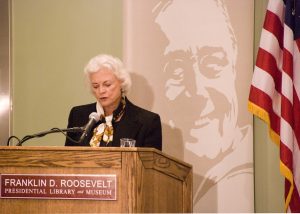Sandra Day O’Connor, the first female Supreme Court Justice, passed away at 93 on Dec. 1 in Phoenix, Ariz.
In a statement, the Supreme Court mentioned that O’Connor passed away due to complications related to advanced dementia, most likely Alzheimer’s, and respiratory illness.
Her dominance after breaking gender barriers upon admission to the United States Judicial Branch indicated an example of effective female authority that later evolved into a wider variety of empowered female political figures and court representatives that would increase equality and gender diversity in this country’s legal system.
Her success would soon serve as the stepping stone for the United States legal system to reflect numerous perspectives, where citizens could have the opportunity to connect with figures that better reflect their unique identities.
This unprecedented journey ignited when former President Ronald Regan appointed O’Connor to the Supreme Court in 1981.
The Republican Justice would soon become a pivotal component to controversial decisions regarding complex topics that pervade American minds daily, including abortion and affirmative action.
She officially declared retirement 24 years later, on July 5, 2005.
O’Connor revealed that her decision to step down from serving the court was rooted in her ailing husband, Jay O’Connor, another vulnerable victim of Alzheimer’s who passed away four years later in 2009.
However, her absence from the Supreme Court catalyzed the gradual yet persistent transition into an era of a conservative majority that negated O’Connor’s highly advocated previous decisions.

O’Connor giving a speech at the FDR Presidential Library and Museum.
Upon O’Connor’s departure, her quite conservative successor, Justice Samuel Alito, filled her empty position in 2006 after former President George W. Bush’s nomination.
Alito’s fulfillment permitted the court’s majority to transition into a perspective that opposed that of O’Connor in certain circumstances.
Her resistance to traditional conservative views allowed her to be considered an ambitious realist with the guts to interfere with the court’s majority by creating divisions.
Nevertheless, the installation of a conservative majority through President Trump’s appointment of Neil Gorsuch, Brett Kavanaugh, and Amy Coney Barrett during his presidency would establish the court’s concrete polarization that culminated in the overturning of Roe V. Wade in 2022 and race-conscious admissions in 2023.
One of O’Connor’s most controversial traits among political parties was her ability to intervene between the conservative and liberal voting blocks of the Supreme Court to reach a more unified consensus. She never sacrificed the quality of her personal beliefs to appease those of her fellow Republicans.
An indication of her adamance was during the 1992 decision Planned Parenthood v. Casey and the 2003 case Grutter v. Bollinger, which were both later overturned by the Supreme Court in 2022 and 2023, respectively, under the control of the court’s present conservative majority.
The Supreme Court had been nicknamed the “O’Connor Court” because of how frequently O’Connor had served as a swing vote that would determine a case’s fate. One of the most outstanding examples of this was during the case Planned Parenthood v. Casey, which reaffirmed the principles of Roe v. Wade that forbade abortion bans on a state level. O’Connor voted in favor of keeping female abortion rights.
O’Connor was born in El Paso, Texas, in 1930 to Harry and Ada Mae Day and later raised on her family’s cattle ranch, nicknamed the “Lazy B.” She was admitted to Stanford University at 16. O’Connor began Law School in her senior year with four brilliant young women accompanying her. She ultimately graduated from Stanford Law School in 1952, recognized for her two-year accelerated degree completion.
Caught in a gender-discriminating legal field, O’Connor faced adversity and even rejected a Los Angeles firm’s offer to serve as their legal secretary. Instead, O’Connor approached her occupation through hard work and determination by working her way up the legal totem pole to achieve her aspirations as a successful lawyer. This extensive yet imperative path to becoming a more prominent name began when she accepted a non-compensational job working for a San Mateo County attorney. Her small-scale occupation decision later progressed into being hired as a deputy county attorney and a civilian attorney with the Army Quartermaster Corps in Frankfurt, Germany.
After beginning her own legal practice and serving in countless other larger-scale legal positions, O’Connor entered the Judicial Branch of the United States of America for the Maricopa County Superior Court.
Some of O’Connor’s most significant professional achievements include her positions as an assistant attorney general of Arizona, a member of the Arizona State Senate, and a judge of the Maricopa County Superior Court.
After O’Connor served as an Arizona Court of Appeals judge upon her appointment in 1979, she would be presented with an opportunity of a lifetime on a silver platter: the chance to increase gender diversity.
With the assistance of Ronald Regan’s female-empowered ideology, O’Connor was appointed to the Supreme Court in 1981 upon Justice Potter Stewart’s departure from the high court.
In a unanimous vote of 99-0, O’Connor was selected as his replacement, officially becoming the first female Supreme Court Justice in 191 years since its inception.
Her monumental selection as an Associate Supreme Court Justice was only followed by five other women: Ruth Bader Ginsburg, who died in 2020, and current justices Sonia Sotomayor, Elena Kagan, Amy Coney Barrett, and Ketanji Brown Jackson.
She had been the centerpiece of the controversial 5-4 decision that settled the 2000 Presidential election drama surrounding candidates Al Gore and former President George W. Bush. She voted in favor of Bush.
O’Connor always cordially invited her colleagues to lunches and focused on cultivating relationships with all her fellow justices, despite their respective political parties.
Unfortunately, in 2018, O’Connor announced in an open letter her removal from everyday society after her diagnosis of early stages of dementia, likely Alzheimer’s disease.
After her death, some of her former colleagues and admirers commemorated her paramount contributions to the Supreme Court while explaining her positive qualities that broke gender barriers in the U.S. legal system.
“A daughter of the American Southwest, Sandra Day O’Connor blazed a historic trail as our Nation’s first female Justice. She met that challenge with undaunted determination, indisputable ability, and engaging candor,” said Chief Justice John Roberts in a statement released by the court.
Although all the current Supreme Court Justices expressed their condolences and respect for O’Connor’s impact, Associate Justice Amy Coney Barrett highlighted O’Connor’s political strengths and critical law analyzing abilities.
“Because of her sharp mind, she became a pivotal justice who has left her mark on American constitutional law. Because of her indomitable spirit, she made the job uniquely hers,” Barrett said, “Sandra Day O’Connor was the perfect trailblazer.”
After she departed from the Supreme Court, O’Connor continued to impact the American people more locally. She established iCivics in 2009 to further develop civil learning.
Liberal Justice Sonia Sotomayor furthered O’Connor’s passion for civil learning as an iCivics’ Governing Board member.
President Obama awarded O’Connor the Presidential Medal of Freedom in 2009, acknowledging her Supreme Court accomplishments and prominence as a figure of female equality.
O’Connor expanded on her gratitude for her golden opportunities and how she transitioned from a small-town girl to a pivotal component of the United States’ law enforcement.
“How fortunate I feel to be an American and to have been presented with the remarkable opportunities available to the citizens of our county,” said O’Connor, “As a young cowgirl from the Arizona desert, I never could have imagined that one day I would become the first woman justice on the U.S. Supreme Court.”
Sandra Day O’Connor’s vital Supreme Court involvement as the first female to be appointed justice is unparalleled. She set the framework for inspirational female figures in a legal setting that continues to evolve as the future presents itself. There seems to be a brighter future ahead with the appointment of the first female vice president, Kamala Harris, at the inauguration of President Joe Biden in January 2022.
However, it is clear that although there is still tremendous room for improvement in our country’s diverse representation, Sandra Day O’Connor constituted a more accepting nation composed of relatable perspectives. She encompassed the principal ideals of anti-discrimination and emphasized embracing differences as assets instead of concealing them as liabilities.
Sources:
https://www.scotusblog.com/2023/12/sandra-day-oconnor-first-woman-on-the-supreme-court-dies-at-93/
https://www.cbsnews.com/news/sandra-day-oconnor-first-woman-on-the-supreme-court-dies-at-93/
https://www.cnbc.com/2023/12/01/sandra-day-oconnor-first-woman-on-supreme-court-dies-at-93.html











































